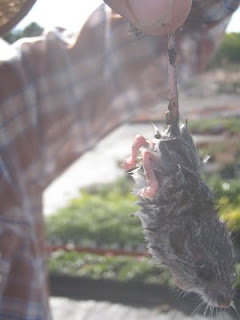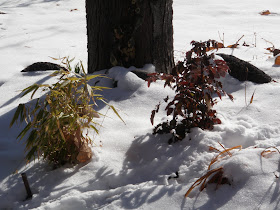
KS: So, Eriogonum corymbosum, or Crispleaf Buckwheat- what would you like me to call you?
EC: Well, friends call me E. corymbosum; I'm mostly known in specialised circles, where they know me by my latin name, but if I find myself on a larger stage, perhaps the public will get tongue-tied and call me -maybe just as hard to say anyway...
KS: Could you introduce Eriogonums in general to readers who may not know about them?
EC: Yeah, sure. We are all North American and major players in the floras of the West. We are among other international "Buckwheats," like the famous fellow who is cultivated argiculturally...
KS: Yes, right...
EC: ..."but we are shrubby little tough plants that do a lot of work out there in terms of diversity and colour in the North American landscape. I'm excited because in recent years, we've gotten some press from the xeric people and native folks. In fact, last year saw the formation of the Eriogonum Society.(http://www.eriogonum.org/)
We're a motley crew, all performing at different things- oh golly, I just love Eriogonum caespitosum's subtle approach to size and use of whitish leaves, she's so great at that- you should go out and see her if you can. My colleagues are all totally fabulous, but I've got to thank Eriogoum umbellatum, gosh, he's be so busy, he's even worked for Plant Select, and has a bunch of cultivars out there, my favourite being those that are bright carmine all winter. His work is getting us more known out there...
KS: Yeah, let me put up a photo for viewes.
EC: Ah, wonderful. Oh, look at him in the snow. Nice.
KS: Indeed, that is actually why I'm interviewing you now out of season- because of what you are doing now, but before that, can you comment on your general work and past summer projects?
EC: Yeah. Well, I'm a not-too well known and taller species of Eriogonum, I'm in the Southwest and Wyoming. I do a nice big cloud of clear to pinkish white flowers (you can check me out on USDA plants) off of leaves that are special- sort of multi-layered surface interest. In Utah, I've got some nice yellow-flowered populations. I prefer more barren places and rocky infertile hillsides where some colourful shrubs are needed. In cultivation, critics say I'm slow growing, but we're working on that despite the fact that that is a totally unfair judgement in a category Americans are just way too caught up on, if you ask me. My contributions are more sophisticated (no offense to the Petunias and Pansies, they have their place) and work well within the sort of rustic gardens and multi-season perennials, but our main goals are sustainability using a cast of local characters. I don't think I'm limited to the sort of harsh twiggy sagebrush gardens, myself, because my current display is adaptable: glowing masses of ruddy remnants of the past season that really catch the light. Anyway, My show in Colorado is on the Western Slope- I'm in the Colorado National Monument...

KS: Congratulations- yeah, I think I saw you there. (Here's a shot for readers). You were quite orange, my favourite. And you did that with an incredibly nasty bentonite slope to work with.
EC: Thanks, yes, that was a sort of monologue where I was at my most raw. some folks will appreciate that. In gardens, I'm more showy, for sure, like in the CSU extension's garden in Grand Junction next to the Fairgrounds- definitely a great production and one of the finest secrets over there-

-Just an absolutely fabulous desert garden that really does deserve more attention. My thanks to Don Campbell and his crew for putting us all together for that spectacular exhibit. Can you put up a general slide of that one for folks?
KS: Sure, here.
The Joshua tree, aka Yucca brevifolia, suprises everyone.
EC: Oh, yes, and there I am between the Chollas. This is where my warmer, softer character works as a good foil to their strong personalities. Plus: white and red, I have always thought, are very classy.
But I am also at Chelsea Nursery (one of my best producers- thank you guys so much!).

Yes, here you can see me with the Blue Avena Grass backing up this wonderfully rusty chair. see, it's that kind of aesthetic I am good with. Some folks just don't see it. If everything isn't a background of turf-green, or they don't see bright pink and other pop junk they are used to, they find it easy to completely overlook our art, but we are working on that.
KS: Right, so just what do you fancy is in store for your future?
EC: Well, I think that the Eriogonum Society betrays that there is a growing interest and growing work on our genus by very capable people- so I am hoping that I will get the attention to be improved to the point that I'd be useful and ready to be cast in the cutting edge of dry-land gardening, because it is work I know well and I think I present some significant contributions- we've got to connect the good actors with the public, but we have to educate them to make that transition happen. Yeah, I think that in time I could be more of a household name, at least among gardeners, but all that depends on the success of the dry and native garden movements as a whole.
KS: Let's hope.
 The fetching Townsendia incana, in the Colorado National Monument, in spring. A low plant needing more attention from dry gardeners. Usually found in a few places here-and-there in the Monument, it is having a field day this year and is growing everywhere, probably to blooming its head off in a favourable year for it to resign to a quiet, invisible presence in the wild seed banks.
The fetching Townsendia incana, in the Colorado National Monument, in spring. A low plant needing more attention from dry gardeners. Usually found in a few places here-and-there in the Monument, it is having a field day this year and is growing everywhere, probably to blooming its head off in a favourable year for it to resign to a quiet, invisible presence in the wild seed banks. I really have got a hobby horse about this native roughneck. Distichlis stricta (aka Distichlis spicata ssp. stricta) It is an agressive underground-running sod former who should be used in places just like this spot above- unirrigated and divided from other cultivated beds. In the right place, it could be one of the most useful groundcovers. Pity it is not available. Note how it is crowding off the Weeds to the bottom right, (perhaps Lamb's Quarter and Puncturevine/Goathead: Atriplex hortensis and Tribulus terrestris respectively). It appears to also be left unmowed. I personally like the blonde look it takes on upon cold weather.
I really have got a hobby horse about this native roughneck. Distichlis stricta (aka Distichlis spicata ssp. stricta) It is an agressive underground-running sod former who should be used in places just like this spot above- unirrigated and divided from other cultivated beds. In the right place, it could be one of the most useful groundcovers. Pity it is not available. Note how it is crowding off the Weeds to the bottom right, (perhaps Lamb's Quarter and Puncturevine/Goathead: Atriplex hortensis and Tribulus terrestris respectively). It appears to also be left unmowed. I personally like the blonde look it takes on upon cold weather. Another sod-former often growing alongside the above Inland Saltgrass and acting much the same, this is scratchgrass, or Muhlenbergia asperifolia. The left side has had a mower take out that pink-ground-cloud-of-glory. Fruita, Colorado.
Another sod-former often growing alongside the above Inland Saltgrass and acting much the same, this is scratchgrass, or Muhlenbergia asperifolia. The left side has had a mower take out that pink-ground-cloud-of-glory. Fruita, Colorado.
 Little Bluestem at its most colourful. I invite the reader to count and note how many entirely different and un-subtle colours there are. The plant will all go to a pinky/rusty/ruddy colour in a few weeks, which is how it will remain all winter until new, blue or purple stems grow in late spring.
Little Bluestem at its most colourful. I invite the reader to count and note how many entirely different and un-subtle colours there are. The plant will all go to a pinky/rusty/ruddy colour in a few weeks, which is how it will remain all winter until new, blue or purple stems grow in late spring. The same colours in a sunset. Nature has agreed on an autumn palette, I see.
The same colours in a sunset. Nature has agreed on an autumn palette, I see.





 Looking East from partway up the side of Mt. Sheridan, which is shoulder-to-shoulder with the more famous Mt. Sherman (a 14-er) to the North.
Looking East from partway up the side of Mt. Sheridan, which is shoulder-to-shoulder with the more famous Mt. Sherman (a 14-er) to the North.































 Galanthus elwesii has been the best performer of three or so species I've tried in the general long run for gardens. It is bigger, earlier, and prettier, ( in my opinion) than G. nivalis (common) or G. ikariae at my old garden in Grand Junction. Also more rugged to mistreatment.
Galanthus elwesii has been the best performer of three or so species I've tried in the general long run for gardens. It is bigger, earlier, and prettier, ( in my opinion) than G. nivalis (common) or G. ikariae at my old garden in Grand Junction. Also more rugged to mistreatment.  Bird's Eye view of part of my first garden. Now that it has had a few years to settle in and fill in, I feel it is time to rip up a part of it whose design I've never liked. I'm so fickle. Just enjoy the different colours in the winter.
Bird's Eye view of part of my first garden. Now that it has had a few years to settle in and fill in, I feel it is time to rip up a part of it whose design I've never liked. I'm so fickle. Just enjoy the different colours in the winter. Bergenia cordata hybrid. It always signs up for bold evergreen burgundy presence. A commonly available plant that ought to be thought of more for that characteristic.
Bergenia cordata hybrid. It always signs up for bold evergreen burgundy presence. A commonly available plant that ought to be thought of more for that characteristic. A new Fargesia nitida and a bird-donated in-situ Mahonia sp. seedling. Both keep the garden's foot in the door so that it does not become invisible in winter. Sometimes I really appreciate the help they lend. The leaves of the Mahonia ("Oregon Grape") are so very nice backlit with winter's low sun, and will go back to dark green right after they have complimented the daffodils. Any design subtleties are accidental for me. Like I wrote, sometimes I really appreciate their (the plant's) work. For instance...
A new Fargesia nitida and a bird-donated in-situ Mahonia sp. seedling. Both keep the garden's foot in the door so that it does not become invisible in winter. Sometimes I really appreciate the help they lend. The leaves of the Mahonia ("Oregon Grape") are so very nice backlit with winter's low sun, and will go back to dark green right after they have complimented the daffodils. Any design subtleties are accidental for me. Like I wrote, sometimes I really appreciate their (the plant's) work. For instance...